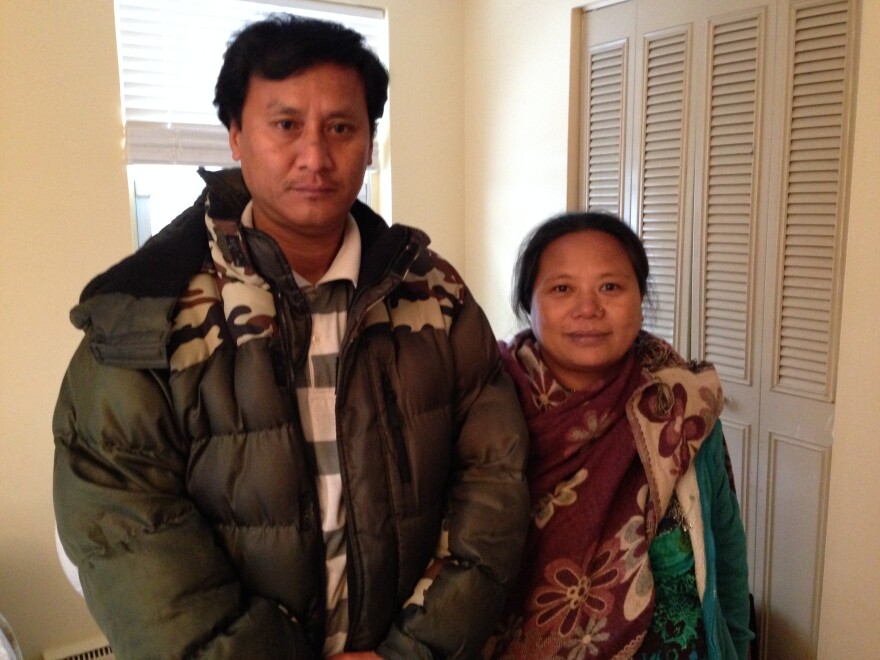In November, a Bhutanese refugee living in Concord killed himself. Nationally, Bhutanese refugees have the highest suicide rate of any refugee population. And here in New Hampshire, where nearly 2,000 Bhutanese refugees have resettled in the last six years, the community is scrambling to answer the questions ‘why does this happen?’ and ‘how do we prevent it?’
Tara Gurung and her husband are moving out of their small apartment in Concord and in with other family members in town. Half-packed cardboard boxes fill the rooms. We sit down in what was their bedroom as she tells me about Ram Gurung, her father.
“My dad was very popular in the camps. There were seven camps and he was popular among them all. He used to give interviews to local radio stations. People knew him.”
At the refugee camp in Nepal, Ram earned the nickname: Patrakar Bajhe, or Journalist Grandad. He would read newspapers to others who couldn’t read.
He and his family lived in the refugee camp for about 20 years. Then, this past September 4th, Ram, who was 73 years old, his wife, two grown daughters and son-in-law arrived in New Hampshire.

“We never saw any warning signs in him. Even back home whenever he heard about somebody attempting suicide, he would counsel them and explain to them that life is beautiful. We never saw him unhappy.”
But on Thanksgiving, Ram Gurung locked himself in his apartment alone and hanged himself.
“At first, when we first saw him lying in the bathroom, I felt he was not dead. The first impression that I had was that he fell down while taking a shower and became unconscious. But later on when the authorities came and checked and found out that he was dead, it was really shocking.”
Tara Gurung still doesn’t know what led to her father’s decision. She says he was happy when he came to the U.S. But he did stress over paying bills and learning English.
Ram Gurung is the first reported Bhutanese refugee to commit suicide in New Hampshire, but one of at least 35 nationally. And for a group of what’s now about 72,000, it’s the highest rate for any refugee population.
The numbers trouble the Centers for Disease Control which began investigating the deaths a few years ago. By early 2012, it had 16 cases to look at from a three year period. The CDC calculated a suicide rate higher than the national and global average. A rate that has held steady through last year.
“The Bhutanese, and I think in general just that part of the world, the perspective on suicide is very different from I think a lot of other populations and ethnicities.”
Doctor Sharmila Shetty was a lead investigator on the CDC report. She says the Hindu and Buddhist cultures don’t have strict taboos against suicide as say Muslim or Western cultures do. But beyond that, Shetty says the causes can be myriad and frustratingly unknowable.
“We didn’t really find anything that was like a ‘smoking gun’ from our investigation. We didn’t find that, you know, everybody was of this characteristic or not.”
In New Hampshire, Bhutanese refugees number about two thousand and make up more than 65% of all refugees who have resettled in the last six years. They’re ethnic Nepali people who were violently forced to leave their homes in Bhutan more than 20 years ago.
“And people were killed, they were asked to leave the country at gunpoint. Women were raped, children were killed and the adult males were taken to prison.”
In 2008, Bhagirath Khatiwada was one of the first Bhutanese refugees to arrive in the state. He’s now a health case worker for Lutheran Social Services in Concord. He met Ram Gurung when he picked up the new arrivals in September.
“People come to America with high expectations and when their expectations are not met, that may trigger them to depression or some suicidal thought.”
Khatiwada says he knows of three recent suicide attempts in New Hampshire. And any uptick concerns Dr. Sharmila Shetty at the CDC.
“There is this phenomenon called suicide contagion.”
If you know someone who ends his or her life or you hear about it, Shetty says, you are more likely to do it yourself. That’s why local and national organizations want to address it proactively. Nearly a year ago, following the CDC’s initial report, the Office of Refugee Resettlement put a suicide hotline number on its front webpage.
And in December, the Bhutanese Community of New Hampshire organized a two-day training session for Bhutanese community leaders that included a celebration of culture and a discussion about suicide.
“There was a very big interest in ‘how do we prevent this? How do we address the high rate of suicide? How do we… what are the warning signs? What do we watch out for?’”
Shelly Stratton of the International Institute facilitated the meetings and led group therapy sessions where refugees talked about what they experienced and witnessed. Stratton says she hopes that by teaching this first group, she’s creating ambassadors who can equip others in the broader community with a greater understanding of their own emotional struggles and the services they have at their disposal.

“But I think one of the most amazing things that did grow out of it was the day of music. They brought their instruments the second day for lunch. And they were just singing and dancing fully. It was kinda hard to stop the music and move back into the workshop.”
And that music, and that communal experience, she says, can be one of the best ways to recover from a collective trauma.
As for Ram Gurung’s family, they are choosing not to dwell on his death. Rather they are focusing on the future, working towards becoming self-sufficient and bringing their extended family closer together.
Click here or call 1-800-273-TALK (8255) to be connected to a skilled, trained counselor at a crisis center in your area, anytime.








